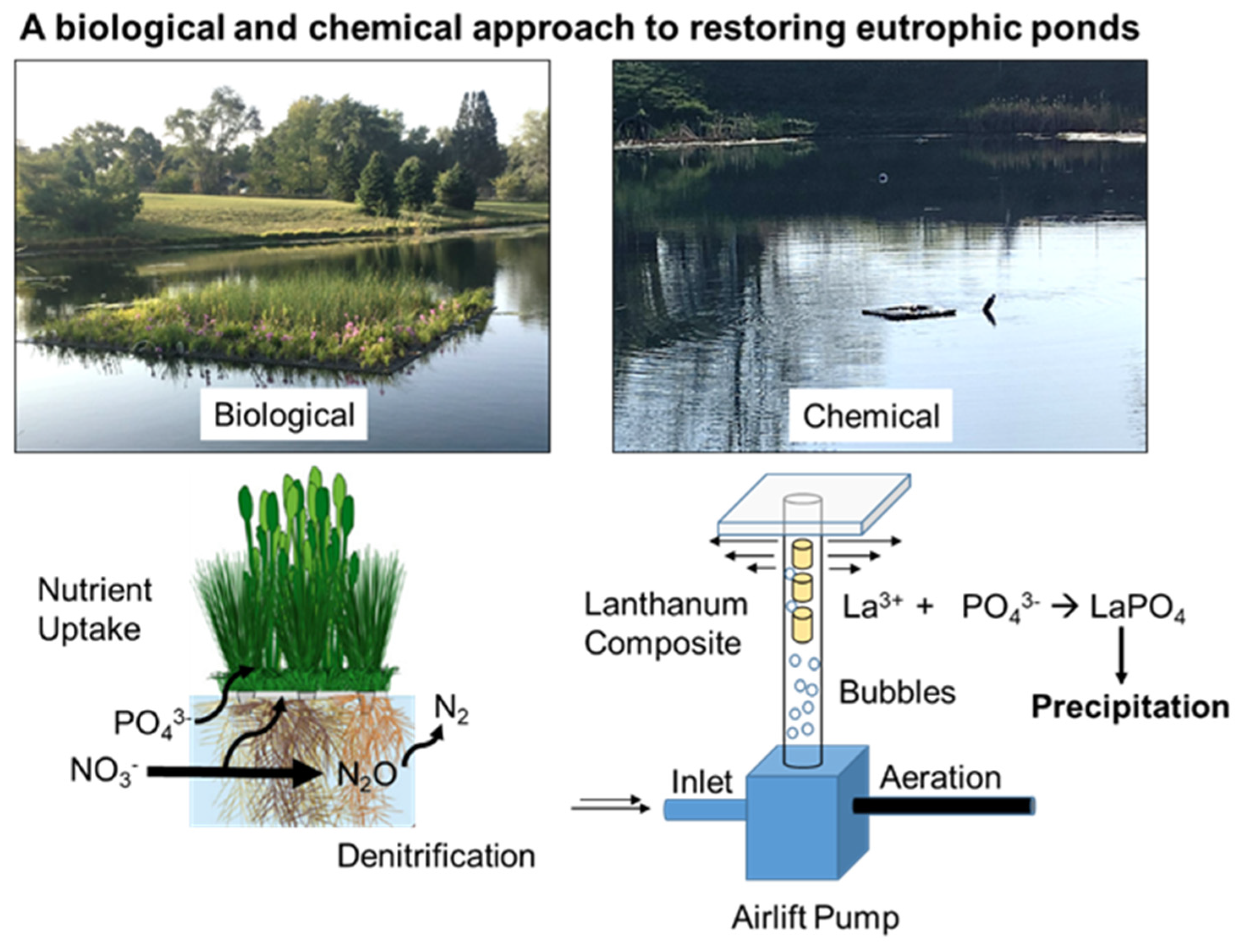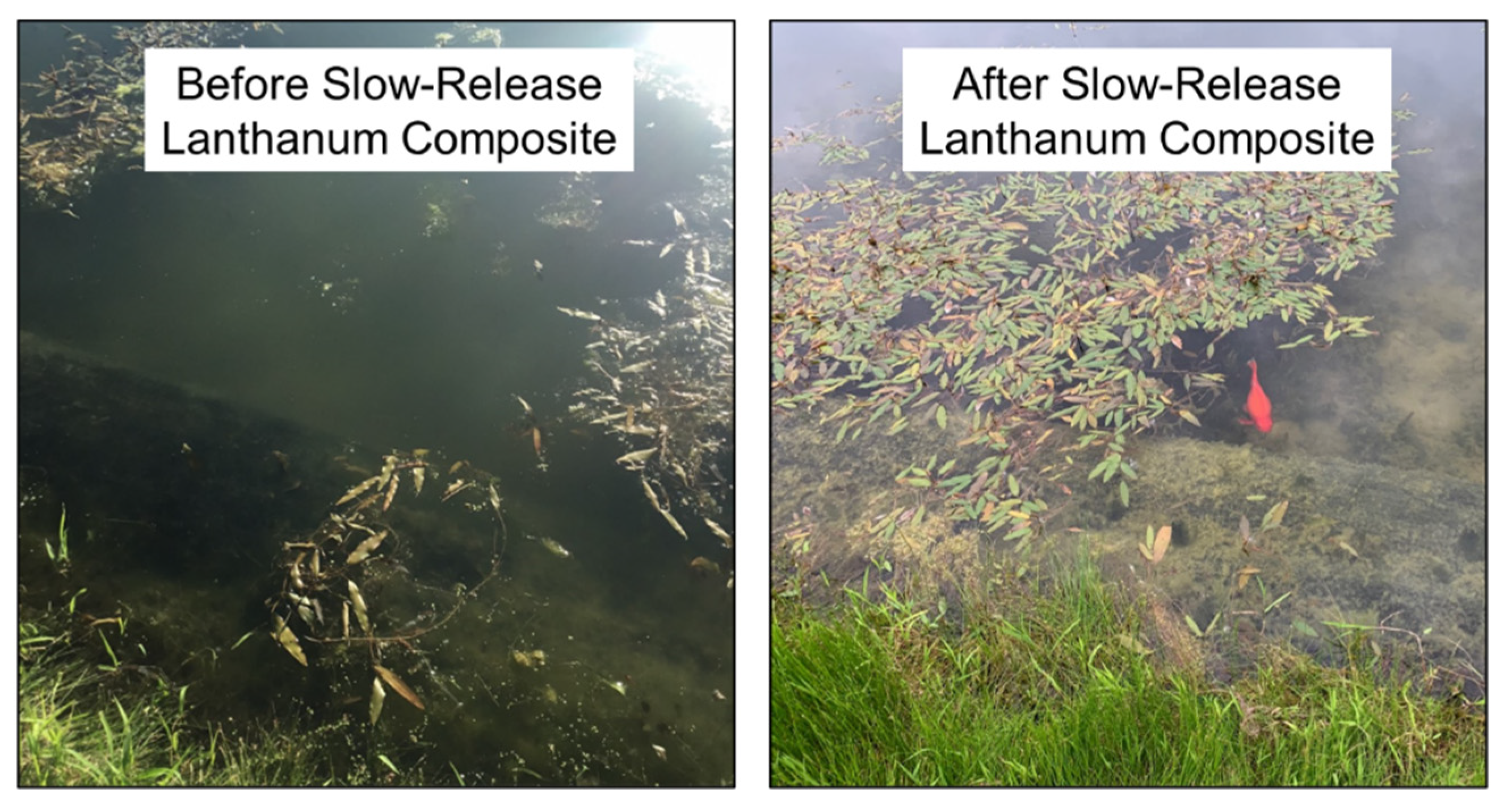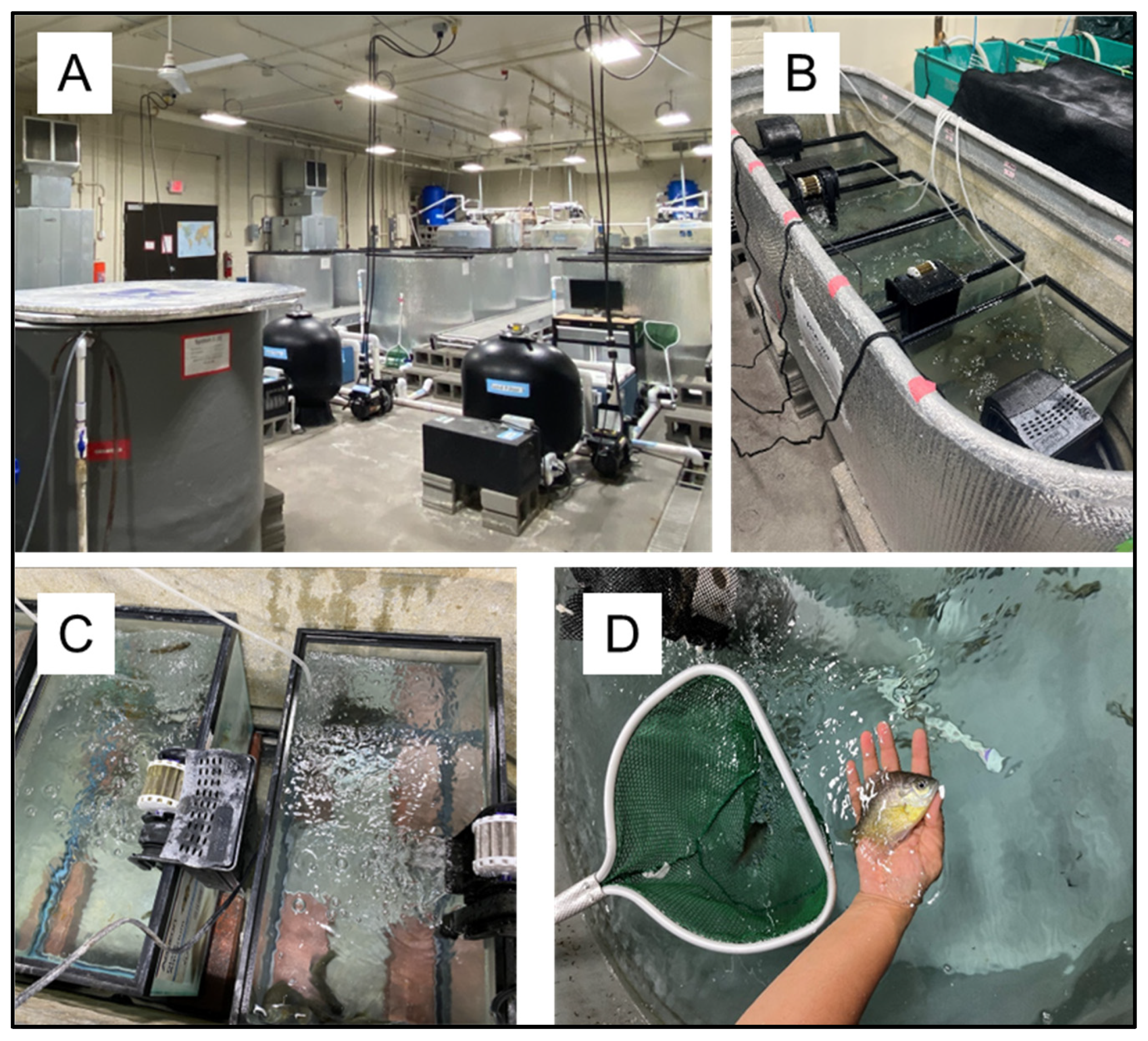Slow-Release Lanthanum Effectively Reduces Phosphate in Eutrophic Ponds without Accumulating in Fish
Abstract
1. Introduction
2. Materials and Methods
2.1. Field Site Description
2.2. Fish Collection and Sampling from Densmore Pond
2.3. Lanthanum-Spiked Aquarium Experiment
2.4. Dissection and Tissue Removal
2.5. Liver, Tissue, and Statistical Analysis
3. Results and Discussion
3.1. Field Site Results: Improvements in Water Quality
3.2. Field Site Results: Fish Analysis
3.3. Controlled Tank Results: Lanthanum Treated versus Control
4. Conclusions
Supplementary Materials
Author Contributions
Funding
Data Availability Statement
Acknowledgments
Conflicts of Interest
References
- Smith, V.H.; Schindler, D.W. Eutrophication science: Where do we go from here? Trends Ecol. Evol. 2009, 24, 201–207. [Google Scholar] [CrossRef]
- Khan, M.N.; Mohammad, F. Eutrophication: Challenges and Solutions. Eutrophication Causes Conseq. Control 2013, 1–15. [Google Scholar] [CrossRef]
- Pieterse, N.M.; Bleuten, W.; Jørgensen, S.E. Contribution of point sources and diffuse sources to nitrogen and phosphorus loads in lowland river tributaries. J. Hydrol. 2003, 271, 213–225. [Google Scholar] [CrossRef]
- Malmqvist, P.-A. Urban Stormwater Pollutant Sources: An Analysis of Inflows and Outflows of Nitrogen, Phosphorus, Lead, Zinc, and Copper in Urban Areas; Chalmers Tekniska Hogskola: Göteborg, Sweden, 1983. [Google Scholar]
- Carpenter, S.R. Phosphorus control is critical to mitigating eutrophication. Proc. Natl. Acad. Sci. USA 2008, 105, 11039–11040. [Google Scholar] [CrossRef]
- Majumdar, D. The Blue Baby Syndrome. Resonance 2003, 8, 20–30. [Google Scholar] [CrossRef]
- Kumar, M.; Puri, A. A review of permissible limits of drinking water. Indian J. Occup. Environ. Med. 2012, 16, 40–44. [Google Scholar] [CrossRef] [PubMed]
- Wurtsbaugh, W.A.; Paerl, H.W.; Dodds, W.K. Nutrients, eutrophication and harmful algal blooms along the freshwater to marine continuum. Wiley Interdiscip. Rev. Water 2019, 6, e1373. [Google Scholar] [CrossRef]
- Glibert, P.; Seitzinger, S.; Heil, C.; Burkholder, J.A.; Parrow, M.; Codispoti, L.; Kelly, V. The role of eutrophication in the global proliferation of harmful algal blooms. Oceanography 2005, 18, 198–209. [Google Scholar] [CrossRef]
- Durham, M.M. Effects of Eutrophication. In Eutrophication: Causes, Consequences and Control; Springer: Dordrecht, The Netherlands, 2013; pp. 29–44. [Google Scholar]
- McKercher, L.J.; Messer, T.L.; Mittelstet, A.R.; Comfort, S.D. A biological and chemical approach to restoring water quality: A case study in an urban eutrophic pond. J. Environ. Manag. 2022, 318, 115463. [Google Scholar] [CrossRef]
- Pavlineri, N.; Skoulikidis, N.T.; Tsihrintzis, V.A. Constructed floating wetlands: A review of research, design, operation and management aspects, and data meta-analysis. Chem. Eng. J. 2017, 308, 1120–1132. [Google Scholar] [CrossRef]
- Zhi, Y.; Zhang, C.; Hjorth, R.; Baun, A.; Duckworth, O.W.; Call, D.F.; Knappe, D.R.U.; Jones, J.L.; Grieger, K. Emerging lanthanum (III)-containing materials for phosphate removal from water: A review towards future developments. Environ. Int. 2020, 145, 106115. [Google Scholar] [CrossRef] [PubMed]
- Yamada-Ferraz, T.M.; Sueitt, A.P.; Oliveira, A.F.; Botta, C.M.R.; Fadini, P.S.; Nascimento, M.R.L.; Faria, B.M.; Mozeto, A.A. Assessment of Phoslock® application in a tropical eutrophic reservoir: An integrated evaluation from laboratory to field experiments. Environ. Technol. Innov. 2015, 4, 194–205. [Google Scholar] [CrossRef]
- Spears, B.M.; Lürling, M.; Yasseri, S.; Castro-Castellon, A.T.; Gibbs, M.; Meis, S.; McDonald, C.; McIntosh, J.; Sleep, D.; Van Oosterhout, F. Lake responses following lanthanum-modified Bentonite clay (Phoslock®) application: An analysis of water column lanthanum data from 16 case study lakes. Water Res. 2013, 47, 5930–5942. [Google Scholar] [CrossRef] [PubMed]
- Yamada-Ferraz, J.A. Lange’s Handbook of Chemistry, 14th ed.; McGraw Hill: New York, NY, USA, 1992. [Google Scholar]
- Bishop, W.M.; Richardson, R.J. Influence of Phoslock® on legacy phosphorus, nutrient ratios, and algal assemblage composition in hypereutrophic water resources. Environ. Sci. Pollut. Res. 2018, 25, 4544–4557. [Google Scholar] [CrossRef] [PubMed]
- FAU IACUC. Guidelines for the Preparation and Use of MS222 (TMS, Tricaine Methanesulfonate) for Animal Procedures. 2014. Available online: https://www.fau.edu/research-admin/comparative-medicine/files/guidelines-for-the-preparation-and-use-of-ms222-final.pdf (accessed on 1 September 2022).
- United States Environmental Protection Agency. Microwave Assisted Acid Digestion of Siliceous and Organically Based Matrices. Method 3052. Available online: https://www.epa.gov/sites/default/files/2015-12/documents/3052.pdf (accessed on 1 September 2022).
- Landman, M.; Brijs, J.; Glover, C.; Ling, N. Lake Okareka and Tikitapu Fish Health Monitoring; Scion Report; SCION: Rotorua, New Zealand, 2007. [Google Scholar]
- Herrmann, H.; Nolde, J.; Berger, S.; Heise, S. Aquatic ecotoxicity of lanthanum—A review and an attempt to derive water and sediment quality criteria. Ecotoxicol. Environ. Saf. 2016, 124, 213–238. [Google Scholar] [CrossRef] [PubMed]
- Hao, S.; Xiaorong, W.; Zhaozhe, H.; Chonghua, W.; Liansheng, W.; Lemei, D.; Zhong, L.; Yijun, C. Bioconcentration and elimination of five light rare earth elements in carp (Cyprinus carpio L.). Chemosphere 1996, 33, 1475–1483. [Google Scholar] [CrossRef]
- Behets, G.J.; Mubiana, K.V.; Lamberts, L.; Finsterle, K.; Traill, N.; Blust, R.; D’Haese, P.C. Use of lanthanum for water treatment a matter of concern? Chemosphere 2020, 239, 124780. [Google Scholar] [CrossRef]
- Mayfield, D.B.; Fairbrother, A. Examination of rare earth element concentration patterns in freshwater fish tissues. Chemosphere 2015, 120, 68–74. [Google Scholar] [CrossRef]
- SePRO Corporation. An Overview of Phoslock and Use in Aquatic Environments; SePRO Corporation: Carmel, IN, USA, 2012. [Google Scholar]
- Albaaj, F.; Hutchison, A.J. Lanthanum carbonate (Fosrenol®): A novel agent for the treatment of hyperphosphataemia in renal failure and dialysis patients. Int. J. Clin. Pract. 2005, 59, 1091–1096. [Google Scholar] [CrossRef]
- Harrison, T.S.; Scott, L.J. Lanthanum carbonate. Drugs 2004, 64, 985–996. [Google Scholar] [CrossRef] [PubMed]
- Reed, P.; Francis-Floyd, R. Red Sore Disease in Game Fish. Florida Cooperative Extension Service, Institute of Food and Agricultural Sciences, University of Florida. 2011. Available online: https://wbefc.org/wp-content/uploads/2017/05/Sores-on-Fish.pdf (accessed on 1 September 2022).
- Arienzo, M.; Ferrara, L.; Trifuoggi, M.; Toscanesi, M. Advances in the Fate of Rare Earth Elements, REE, in Transitional Environments: Coasts and Estuaries. Water 2022, 14, 401. [Google Scholar] [CrossRef]
- United Nations Department of Economic and Social Affairs. Sustainable Development. Available online: https://sdgs.un.org (accessed on 13 January 2023).







| Organ | Average (µg g−1) | Number of Samples | Standard Deviation | p-Value | Significance (α = 0.05) |
|---|---|---|---|---|---|
| Flesh | 0.50 | 11 | 0.46 | 0.30 | Not significant |
| Liver | 1.02 | 10 | 1.56 |
| Treatment/Organs | Average (µg g−1) | Number of Samples | Standard Deviation | p-Value | Significance (α = 0.05) |
|---|---|---|---|---|---|
| Lanthanum—Flesh | 0.50 | 11 | 0.46 | 0.18 | Not significant |
| Control—Flesh | 0.27 | 9 | 0.20 | ||
| Lanthanum—Liver | 1.02 | 10 | 1.55 | 0.31 | Not significant |
| Control—Liver | 0.33 | 6 | 0.32 |
| Treatment/Organs | Average (µg g−1) | Number of Samples | Standard Deviation | p-Value | Significance (α = 0.05) |
|---|---|---|---|---|---|
| Lanthanum—Flesh | 3.54 | 6 | 1.80 | 0.27 | Not significant |
| Control—Flesh | 2.63 | 7 | 0.98 | ||
| Lanthanum—Liver | 1.92 | 7 | 2.05 | 0.31 | Not significant |
| Control—Liver | 2.71 | 7 | 0.32 |
| Treatment/Organs | Average (µg g−1) | Number of Samples | Standard Deviation | p-Value | Significance (α = 0.05) |
|---|---|---|---|---|---|
| FE—Flesh | 3.54 | 6 | 1.80 | 0.86 | Not significant |
| PD—Flesh | 3.86 | 5 | 4.07 | ||
| FE—Liver | 1.92 | 7 | 2.05 | 0.14 | Not significant |
| PD—Liver | 4.91 | 5 | 4.44 |
Disclaimer/Publisher’s Note: The statements, opinions and data contained in all publications are solely those of the individual author(s) and contributor(s) and not of MDPI and/or the editor(s). MDPI and/or the editor(s) disclaim responsibility for any injury to people or property resulting from any ideas, methods, instructions or products referred to in the content. |
© 2023 by the authors. Licensee MDPI, Basel, Switzerland. This article is an open access article distributed under the terms and conditions of the Creative Commons Attribution (CC BY) license (https://creativecommons.org/licenses/by/4.0/).
Share and Cite
McCright, C.; McCoy, J.; Robbins, N.; Comfort, S. Slow-Release Lanthanum Effectively Reduces Phosphate in Eutrophic Ponds without Accumulating in Fish. Environments 2023, 10, 20. https://doi.org/10.3390/environments10020020
McCright C, McCoy J, Robbins N, Comfort S. Slow-Release Lanthanum Effectively Reduces Phosphate in Eutrophic Ponds without Accumulating in Fish. Environments. 2023; 10(2):20. https://doi.org/10.3390/environments10020020
Chicago/Turabian StyleMcCright, Callie, Jenna McCoy, Natalie Robbins, and Steve Comfort. 2023. "Slow-Release Lanthanum Effectively Reduces Phosphate in Eutrophic Ponds without Accumulating in Fish" Environments 10, no. 2: 20. https://doi.org/10.3390/environments10020020
APA StyleMcCright, C., McCoy, J., Robbins, N., & Comfort, S. (2023). Slow-Release Lanthanum Effectively Reduces Phosphate in Eutrophic Ponds without Accumulating in Fish. Environments, 10(2), 20. https://doi.org/10.3390/environments10020020





